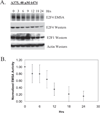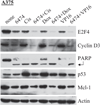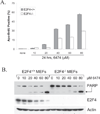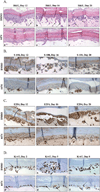A small-molecule E2F inhibitor blocks growth in a melanoma culture model
- PMID: 18676853
- PMCID: PMC3615411
- DOI: 10.1158/0008-5472.CAN-08-0121
A small-molecule E2F inhibitor blocks growth in a melanoma culture model
Abstract
HLM006474 was identified using a computer-based virtual screen and the known crystal structure of the DNA-bound E2F4/DP2 heterodimer. Treatment of multiple cell lines with HLM006474 resulted in the loss of intracellular E2F4 DNA-binding activity as measured by electrophoretic mobility shift assay within hours. Overnight exposure to HLM006474 resulted in down-regulation of total E2F4 protein as well as known E2F targets. The effects of HLM006474 treatment on different cell lines varied but included a reduction in cell proliferation and an increase in apoptosis. HLM006474 induced apoptosis in a manner distinct from cisplatin and doxorubicin. E2F4-null mouse embryonic fibroblasts were less sensitive than wild-type counterparts to the apoptosis-inducing activity of the compound, revealing its biological specificity. A375 cells were extremely sensitive to the apoptosis-inducing activity of the compound in two-dimensional culture, and HLM006474 was a potent inhibitor of melanocytes proliferation and subsequent invasion in a three-dimensional tissue culture model system. Together, these results suggest that interference with E2F activity using small molecules may have clinical application in cancer therapy.
Figures






Similar articles
-
E2F inhibition synergizes with paclitaxel in lung cancer cell lines.PLoS One. 2014 May 15;9(5):e96357. doi: 10.1371/journal.pone.0096357. eCollection 2014. PLoS One. 2014. PMID: 24831239 Free PMC article.
-
Deregulated E2F transcriptional activity in autonomously growing melanoma cells.J Exp Med. 2000 Mar 20;191(6):1005-16. doi: 10.1084/jem.191.6.1005. J Exp Med. 2000. PMID: 10727462 Free PMC article.
-
Adenovirus-mediated E2F-1 gene transfer sensitizes melanoma cells to apoptosis induced by topoisomerase II inhibitors.Cancer Res. 2002 Mar 15;62(6):1776-83. Cancer Res. 2002. PMID: 11912154
-
TGFbeta-mediated formation of pRb-E2F complexes in human myeloid leukemia cells.Biochem Biophys Res Commun. 2008 May 2;369(2):277-80. doi: 10.1016/j.bbrc.2008.02.051. Epub 2008 Feb 21. Biochem Biophys Res Commun. 2008. PMID: 18294958 Review.
-
Rb/E2F: a two-edged sword in the melanocytic system.Cancer Metastasis Rev. 2005 Jun;24(2):339-56. doi: 10.1007/s10555-005-1582-z. Cancer Metastasis Rev. 2005. PMID: 15986142 Review.
Cited by
-
Amino Acid Deprivation-Induced Autophagy Requires Upregulation of DIRAS3 through Reduction of E2F1 and E2F4 Transcriptional Repression.Cancers (Basel). 2019 Apr 30;11(5):603. doi: 10.3390/cancers11050603. Cancers (Basel). 2019. PMID: 31052266 Free PMC article.
-
Antitumor and modeling studies of a penetratin-peptide that targets E2F-1 in small cell lung cancer.Cancer Biol Ther. 2013 Aug;14(8):742-51. doi: 10.4161/cbt.25184. Epub 2013 Jun 3. Cancer Biol Ther. 2013. PMID: 23792570 Free PMC article.
-
Classic "broken cell" techniques and newer live cell methods for cell cycle assessment.Am J Physiol Cell Physiol. 2013 May 15;304(10):C927-38. doi: 10.1152/ajpcell.00006.2013. Epub 2013 Feb 7. Am J Physiol Cell Physiol. 2013. PMID: 23392113 Free PMC article. Review.
-
E2F1 Expression and Apoptosis Initiation in Crayfish and Rat Peripheral Neurons and Glial Cells after Axonal Injury.Int J Mol Sci. 2022 Apr 18;23(8):4451. doi: 10.3390/ijms23084451. Int J Mol Sci. 2022. PMID: 35457270 Free PMC article.
-
Deregulated E2F Activity as a Cancer-Cell Specific Therapeutic Tool.Genes (Basel). 2023 Feb 2;14(2):393. doi: 10.3390/genes14020393. Genes (Basel). 2023. PMID: 36833320 Free PMC article. Review.
References
-
- Sage J. Hope in sight for retinoblastoma. Nat Med. 2007;13(1):30–31. - PubMed
-
- La Thangue NB. The yin and yang of E2F-1: balancing life and death. Nat Cell Biol. 2003;5(7):587–589. - PubMed
-
- Johnson DG, Degregori J. Putting the Oncogenic and Tumor Suppressive Activities of E2F into Context. Current molecular medicine. 2006;6(7):731–738. - PubMed
-
- Kong LJ, Chang JT, Bild AH, Nevins JR. Compensation and specificity of function within the E2F family. Oncogene. 2007 - PubMed
-
- Trimarchi JM, Lees JA. Sibling rivalry in the E2F family. Nat Rev Mol Cell Biol. 2002;3(1):11–20. - PubMed
Publication types
MeSH terms
Substances
Grants and funding
LinkOut - more resources
Full Text Sources
Other Literature Sources

